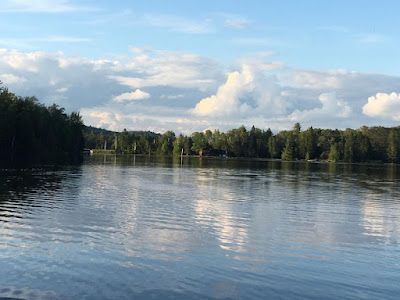It's time to lay out the North River Bridge section. The layout design
given and druthers of this section is identified in Station 6 - North River Bridge.
Layout Design Elements
The North River Bridge section adjoins the Preachers Slough section to the north and the Wickwood section to
the south. It has seven scenic elements (from backdrop to fascia):
This module consists of eight layout design elements:
- A partly cloudy sky suggesting sunny weather.
- A mid-distant treeline with a river disappearing in the distance.
- A low dam in the background.
- A wide deep river with relatively high river banks.
- One through truss bridge .
- Two through plate girder bridges.
- Two stone abutments.
- Two stone piers.
- A wide shallow river with low river banks.
Module Construction
See the WWSL module construction
reference page for the construction technique.
As this module is a
river
module I have modified the construction technique. Instead of using the
two 1"x3" girders on the bottom of the module, I need a solid bottom on
the
module for the riverbed. The 1"x3" girders are replaced by a 2-foot by 8-foot piece of plywood, 3/4 inches thick. The two
ends of the module are cut out to permit attachment of the module
electrical connectors and module interface bolts.
The remainder of the
module is built per standard WWSL construction standards.

ROW Design Considerations
The most critical design
considerations on this module is the length of the bridge. With only 96
inches of linear space to model two river banks and three bridges, something has to be compressed.
First
I looked at the
two curved legs. At Wickwood, the 26-inch radius curve needs to connect
to
a tangent track located 12 inches from the front fascia. That means
that 16 inches of space is needed on this module for the south mainline
curve.
At Preachers Slough, the 26-inch radius curve needs to
connect to a tangent track located 16 inches from the front fascia. This
means that 10 inches of space is needed on this module for the south
main line curve. A total of approximately 26
inches is needed for the curved main line components. That leaves us
with 70 inches of tangent mainline track for the three bridges.
4.The
through truss bridge is a Central Valley bridge kit.
Total length of that bridge will be 21 inches. See 4.1.9.12 North River
Bridge S5 (Through Truss (Pratt)) for construction details.
5.
The through plate girder bridges are Central Valley bridge kits. Each
bridge is 10 inches long, for a total of 20 inches, See 4.1.9.12 North
River Bridge S5 (Through Plate Girder) for construction details. With
the through truss bridge, the total length is 41 inches - plenty of
room for the bridge.
6. The abutments will will be Chooch stone abutments. They require some modification - the overall height is good but the bridge step needs to be increased to permit the installation of appropriate bridge pedestals. See 4.1.9.12 North River Bridge S5a (Masonry Abutments) for
construction
details.
7. The in-river piers will be Chooch stone piers. They require a similar
reduction in height only. See 4.1.9.12 North River Bridge S5b (Masonry Piers) for construction details.
Laying out the Structures
I used a pair of 3 foot yard sticks to determine the anticipated
length of the bridge complex (53 inches) and for initial siting of the
river banks and the bulkhead, piers and concrete abutment.
Essentially you're going to follow this process:
- Lay out the Bridge complex. It will be centered on the module.
- Locate the abutments and piers.
- Lay out the Dam complex.The dam will be centered and extend approximately 4 inches into the module.
- Lay out the river banks
I have considered adding some structures in support of the dam but haven't determined what specifically will be added. See the Structures Reference Page
for the specific details about those structures.
Laying out the Right of Way
I am not going to go into great detail about putting down the roadbed lines. See the Right of Way Reference Page for the details if you haven't had the fun to do it before.
Essentially you're going to follow this process:
- Lay out the main line. I centered it at the 12 inch line.
- Lay out the main line curves with easements.
- Lay out the bridge template, the length of the bridge and adjust as necessary.
- Lay out the south embankment leading to the bridges.
- Locate the abutments and pier.
- Layout the river banks on either side of the river.
Because
this module ties into both the Wickwood Module and the Preachers Slough
module some layout of those modules will need to be done
at the same time, primarily the main line locator at Wickwood (12 inches
from the fascia) and the southernmost Preachers Slough curve (16 inches
from the fascia).
Roadway Details
- The WWSL 2nd Division is
designated Class A main line. See 4.2.11.1 Modeling Technique for High Profile
Roadway for details.
- Bridge Profile. See 4.2.11.16 Modeling Technique for Bridge Roadway for details.
Right of Way Drainage. See 4.1.8
Ditches, Drains and Culverts
MOW Details
- 4.2.12.5 Rail Rests
- 4.2.12.6 Tie Stack Detail
Track Details.
.
In the next blog (Section 6 - North River Bridge Module - Part 2) I will discuss the Scenic Design Considerations.
Reference
See 4.2.3 Laying Straight Track and 4.2.4 Laying Curve Track for construction details.






















.JPG)

